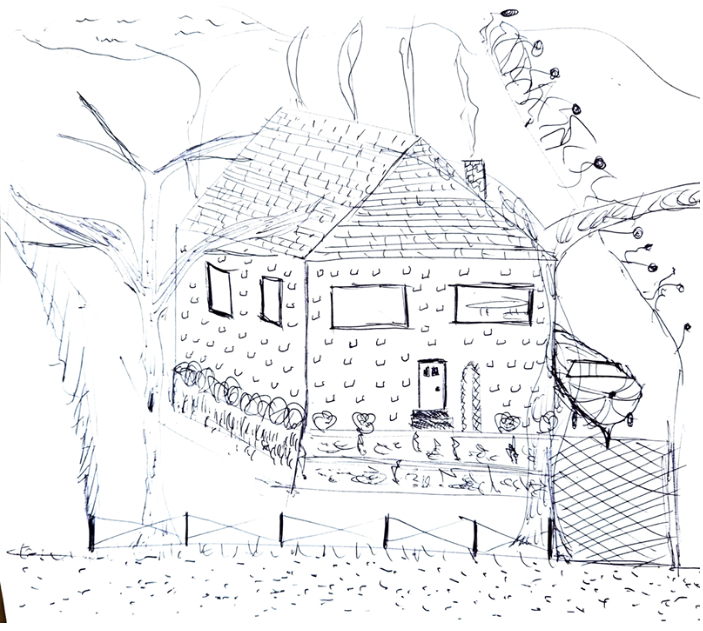
This is my childhood home on Cape Cod. My family moved when I was 15, but the house on Edgewater Drive (a dirt road) will always feel like “home” to me. I made sure to include details I’ll never forget, like its simple, split-level design with shingled siding—nothing too fancy. My dad and I built that fence, poured the cement driveway, and constructed the lattice overhang together (also built a deck and sun-room in the back, he is very skilled at construction and a handyman). I also maintained the yard every year, adding bark mulch, so I included the tiered garden beds and the plants I remember.
I drew the trees I used to climb, the rose bushes that bordered one side of the property, and the boat I learned to water ski on. There are no pets in the drawing, and it’s not meant to be a dream home. It’s simply where my journey began. As the saying goes, “If you don’t know where you’ve been, it’s hard to know where you’re going.”
Reflection
Reflecting on this Goldilocks activity feels like an exploration into the framework of “triadic reciprocity,” which emphasizes the interconnected relationships between individuals, their behaviors and perspectives, and their environment (Schunk, 2020). In this case, we were all given the same task in the same environment (our online class) but approached it in various ways (behavioral), influenced by our internal cognitions (personal factors). Some of us drew by hand, others used graphic design programs, and some even had an LLM like Gemini generate an image. These images often represented dream homes, current homes, or childhood homes and were accompanied by explanations detailing the thought process behind them. Our interpretations of the task were, in part, shaped by our “perceived self-efficacy,” which refers to our belief in our ability to organize and execute actions to achieve a specific goal (Schunk, 2020). From reading the various posts, we can see how differently each individual interpreted the activity to get it “just right,” much like Goldilocks finding the perfect bed.
When adjusting an activity for a different audience, we can explore how the cognitivist concept of modeling can impact learning. Modeling involves learning through observation, which goes beyond mere imitation and promotes deeper understanding. In creating dialogue within a classroom, it’s crucial not to model behaviors that might distract learners from the material or disrupt how they retain and process information, as this can affect their motivation. Bandura (1997) explains that “learners cognitively process what they observe and form expectations about anticipated outcomes of actions based on consequences experienced by themselves and models” (Bandura, 1997, as cited in Schunk, 2020, p. 134).
For example, if I were working with underprivileged students and asked them to draw a home, but I drew a mansion with a yacht and a new truck in the driveway, I might unintentionally alienate the students. This could cause feelings of jealousy or resentment, distracting them from the lesson. Instead, I could draw my old, hail-damaged Nissan Sentra that I drove and lived in during the recession of 2008. I could then talk about the steps I took to improve my situation, rather than boasting about how good my life is now. This approach would likely foster more connection and understanding.
Even in my current drawing, where I included a small 19-foot boat and a white picket fence, I realize that these details, while meaningful to me, might evoke judgments or feelings of jealousy from students who may not have had similar privileges. Social cognitive theory teaches us that people’s expectations are shaped by their personal experiences, and I will have the best chance of reaching these students if they see behaviors modeled by someone they can relate to. If I come across as snobby or out of touch, the students might dismiss what I say as irrelevant or unimportant. It’s difficult to be an effective mentor or tutor when judgments prevent students from developing self-efficacy in performing the behaviors being taught. This is a valuable perspective to keep in mind for future instructional activities.

Leave a Reply
You must be logged in to post a comment.